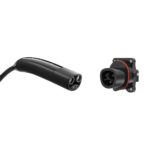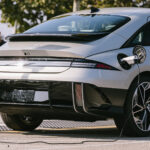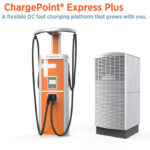Is it really true that Ford plans to adopt Tesla’s NACS charging standard? Yeah, you’re reading that right. Ford and Tesla just announced a significant agreement related to electric vehicle charging – specifically, the Tesla Supercharging network and the use of Tesla’s North American Charging Standard (NACS) in Ford EVs.
The main point of the deal is that starting in the spring of 2024, Ford EV users will gain access to more than 12,000 Tesla Superchargers (or charging stalls) across the United States and Canada, in addition to the existing 10,000+ CCS1 DC fast chargers that are already included in Ford’s BlueOval Charge Network. Right now, Ford’s charging standard uses the Combined Charging System (or CCS1) connector. But according to the agreement, the Ford Mustang Mach-E, F-150 Lightning, and E-Transit vehicles will be able to access the Superchargers with an adapter and software integration, along with activation and payment via FordPass or Ford Pro Intelligence.
In other words, it’s something beyond the Non-Tesla Supercharger Pilot Program, which was launched in the US in March 2023. That program allowed the use of select Superchargers (currently about ten stations) by CCS1-compatible EVs, through the Magic Dock, a built-in CCS1 adapter, and a Tesla app account. As we understand it, Ford customers will be equipped with a new Tesla-developed adapter (NACS to CCS1) that can use any Tesla Supercharger –even those without the Magic Dock– while operating solely within Ford’s own app.
This move opens the entire Tesla Supercharging network for existing Ford EVs without sacrificing CCS1 compatibility. The important thing is that the entire authorization and payment process is expected to be very simple, seamless, and kept within Ford’s domain.
The second announcement about the NACS charging inlet is even more significant, which will be used in Ford’s next-generation electric vehicles in North America starting in 2025.
“In 2025, Ford will offer next-generation electric vehicles with the North American Charging Standard (NACS) connector built-in, eliminating the need for an adapter to access Tesla Superchargers”
It means that Ford’s charging standard will be changed in new models to be natively compatible with the NACS (and the Tesla Supercharging network) just like Tesla vehicles, including the seamless plug-and-charge feature.
Backward compatibility with CCS1 fast chargers will likely be secured through Tesla’s CCS1 to NACS adapter, which is currently offered by Tesla for its own customers. We would not expect to see both NACS and CCS1 charging inlets installed on a vehicle after Ford’s charging standard has changed.
Of course, customers will have to ensure they have a NACS-compatible home charging unit (or adapters to the SAE J1772 connector) as well, but that’s a minor, temporary issue during the transition period.
Overall, the change to Ford’s charging standard is a groundbreaking switch that could completely change the EV charging landscape. Other manufacturers may also be willing to install a NACS charging connector now. Let’s recall that the NACS is Tesla’s proprietary charging connector for AC and DC charging, which in December 2022 was opened for the industry and renamed the North American Charging Standard. With Ford on board, Aptera already signed in, and other EV manufacturers or charging networks potentially joining up, the NACS might really become the North American standard for AC and DC charging.
Jim Farley, the president and CEO of Ford, said:
“This is great news for our customers who will have unprecedented access to the largest network of fast-chargers in the U.S. and Canada with 12,000+ Tesla Superchargers plus 10,000+ fast-chargers already in the BlueOval Charge Network. Widespread access to fast-charging is absolutely vital to our growth as an EV brand, and this breakthrough agreement comes as we are ramping up production of our popular Mustang Mach-E and F-150 Lightning, and preparing to launch a series of next-generation EVs starting in 2025.”
Rebecca Tinucci, Tesla’s senior director of charging infrastructure, added:
“We’ve spent the last 10 years building an industry-leading Charging Network that enables freedom to travel and provides charging confidence for our Tesla owners. We’re excited to deliver on our mission to accelerate the world’s transition to sustainable energy by welcoming Ford owners, and other electric vehicles who adopt NACS, to our thousands of Superchargers across North America.”
Marin Gjaja, the chief customer officer of the Ford Model e, said:
“Tesla has led the industry in creating a large, reliable and efficient charging system and we are pleased to be able to join forces in a way that benefits customers and overall EV adoption. The Tesla Supercharger network has excellent reliability and the NACS plug is smaller and lighter. Overall, this provides a superior experience for customers.”










0 Comments